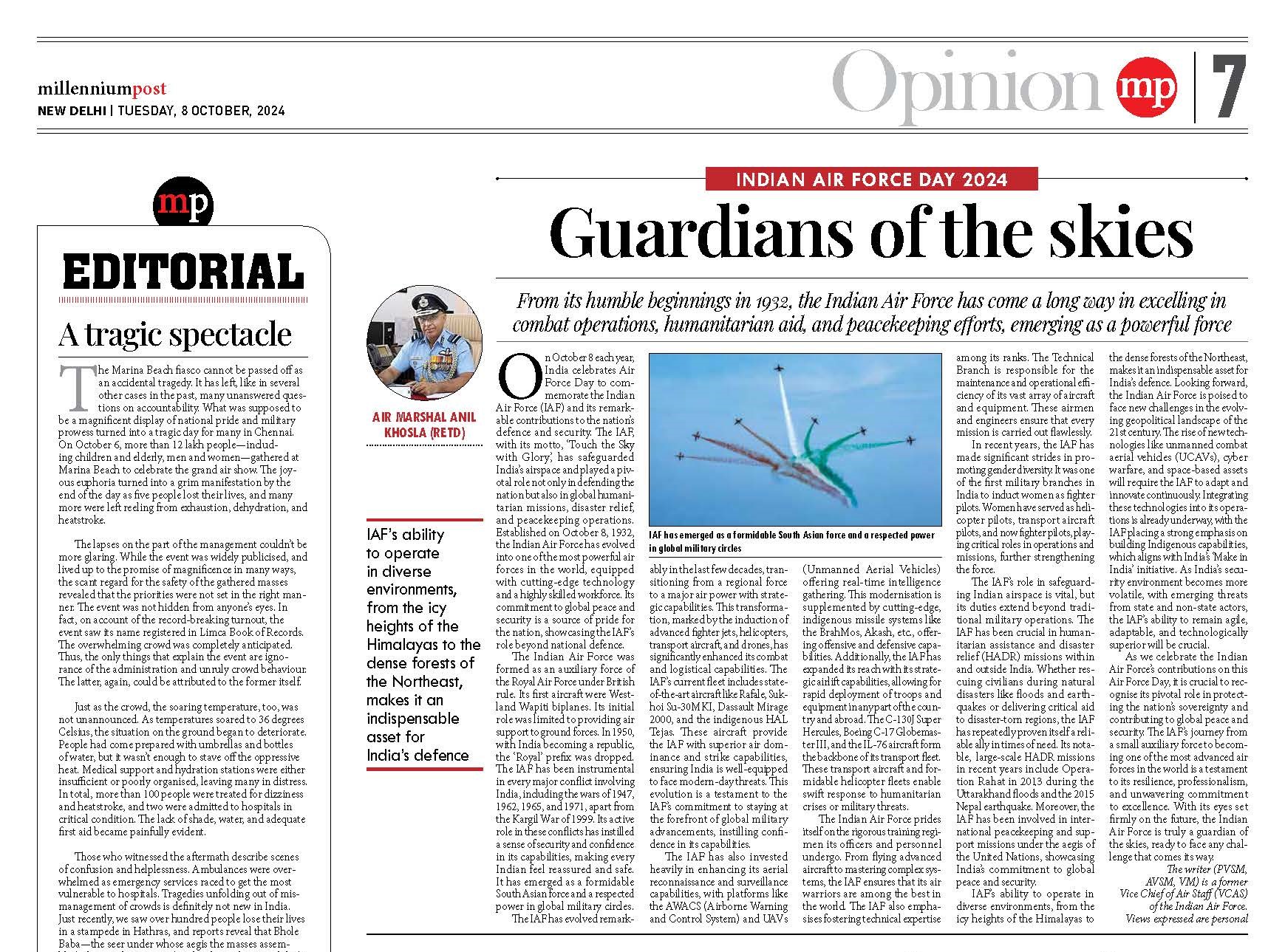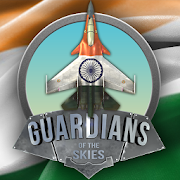
My Article published in the Millennium Post e-paper
On 08 October each year, India celebrates Air Force Day to commemorate the Indian Air Force (IAF) and its remarkable contributions to the nation’s defence and security. The IAF, with its motto “Touch the Sky with Glory,” has safeguarded India’s airspace and played a pivotal role in defending the nation and in global humanitarian missions, disaster relief, and peacekeeping operations. Established on October 8, 1932, the Indian Air Force has evolved into one of the most powerful air forces in the world, equipped with cutting-edge technology and a highly skilled workforce.
The Indian Air Force was formed as an auxiliary air force of the Royal Air Force under British rule. Its first aircraft were Westland Wapiti biplanes. Its initial role was limited to providing air support to ground forces. In 1950, with India becoming a republic, the “Royal” prefix was dropped. The IAF has been instrumental in every major conflict involving India, including the wars of 1947, 1962, 1965 and 1971 and the Kargil War of 1999, instilling a sense of security and confidence in its capabilities. It has emerged as a formidable South Asian force and a respected power in global military circles.

The IAF has undergone significant modernisation in the last few decades, evolving from a regional force to a major air power with strategic capabilities. This transformation, marked by the induction of advanced fighter jets, helicopters, transport aircraft, and drones, has enhanced its combat and logistical capabilities. The IAF’s current fleet includes state-of-the-art aircraft like the Rafale, Sukhoi Su-30MKI, Dassault Mirage 2000, and the indigenous HAL Tejas. These aircraft provide the IAF with superior air dominance and strike capabilities, ensuring India is well-equipped to face modern-day threats.
The IAF has also invested heavily in enhancing its aerial reconnaissance and surveillance capabilities, with platforms like the AWACS (Airborne Warning and Control System) and UAVs (Unmanned Aerial Vehicles) for real-time intelligence gathering. This modernisation is supplemented by cutting-edge indigenous missile systems like the BrahMos and Akash etc, which offer offensive and defensive capabilities. In addition, the IAF has expanded its reach with its strategic airlift capabilities, allowing for rapid deployment of troops and equipment in any part of the country and even internationally. The C-130J Super Hercules, Boeing C-17 Globemaster III, and the IL-76 aircraft form the backbone of its transport fleet, enabling swift response to humanitarian crises or military threats.
The Indian Air Force prides itself on the rigorous training regimen its officers and personnel undergo. From flying advanced aircraft to mastering complex systems, the IAF ensures that its air warriors are among the best in the world. The IAF also emphasises fostering technical expertise among its ranks. The Technical Branch is responsible for the maintenance and operational efficiency of its vast array of aircraft and equipment. These airmen and engineers ensure that every mission is carried out flawlessly.
In recent years, the IAF has made significant strides in promoting gender diversity. It was one of the first military branches in India to induct women as fighter pilots. Women have served as helicopter pilots, transport aircraft pilots, and now fighter pilots, playing critical roles in operations and missions, further strengthening the force.
The IAF’s role in safeguarding Indian airspace is vital, but its duties extend beyond traditional military operations. The IAF has been crucial in humanitarian assistance and disaster relief (HADR) missions within and outside India. Whether rescuing civilians during natural disasters like floods and earthquakes or delivering critical aid to war-torn regions, the IAF has repeatedly proven itself as a force for good. Its notable large-scale HADR missions in recent years include Operation Rahat in 2013 during the Uttarakhand floods and the 2015 Nepal earthquake.
Moreover, the IAF has been involved in international peacekeeping and support missions under the aegis of the United Nations, showcasing India’s commitment to global peace and security. Its ability to operate in diverse environments, from the icy heights of the Himalayas to the dense forests of the Northeast, makes it an indispensable asset for India’s defence.
Looking forward, the Indian Air Force is poised to face new challenges in the evolving geopolitical landscape of the 21st century. The rise of new technologies like unmanned combat aerial vehicles (UCAVs), cyber warfare, and space-based assets will require the IAF to adapt and innovate continuously. Integrating these technologies into its operations is already underway, with the IAF placing a strong emphasis on building Indigenous capabilities, in line with India’s “Make in India” initiative. As India’s security environment becomes more volatile, with emerging threats from state and non-state actors, the IAF’s ability to remain agile, adaptable, and technologically superior will be crucial.
As we celebrate the Indian Air Force’s contributions on this Air Force Day, it is crucial to recognise its pivotal role in protecting the nation’s sovereignty and contributing to global peace and security. The IAF’s journey from a small auxiliary force to one of the most advanced air forces in the world is a testament to its resilience, professionalism, and unwavering commitment to excellence. With its eyes set firmly on the future, the Indian Air Force is truly a guardian of the skies, ready to face any challenge that comes its way.
Your valuable comments are most welcome.
For regular updates, please register your email here:-
References and credits
To all the online sites and channels.
Disclaimer:
Information and data included in the blog are for educational & non-commercial purposes only and have been carefully adapted, excerpted, or edited from reliable and accurate sources. All copyrighted material belongs to respective owners and is provided only for wider dissemination.
